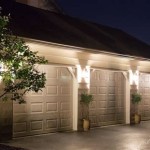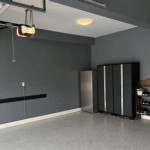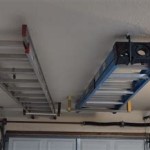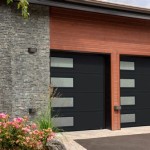A Guide To Painting Garage Walls And Ceilings
Painting a garage's walls and ceiling can significantly enhance its appearance and functionality. A fresh coat of paint brightens the space, making it more inviting and easier to clean. Additionally, painting can protect surfaces from moisture and wear, extending their lifespan. This guide provides a comprehensive overview of the necessary steps involved in achieving a professional-looking paint job in a garage.
Preparation is Paramount
Thorough preparation is the foundation of a successful painting project. Skipping or rushing these steps can lead to uneven coverage, peeling paint, and a less-than-desirable final result. Proper preparation involves cleaning, patching, and priming the surfaces to be painted.
The first step is to completely empty the garage. Remove all vehicles, tools, storage containers, and other items. If certain large items are immovable, cover them securely with plastic sheeting to protect them from dust and paint splatters. This provides unobstructed access to the walls and ceiling, ensuring a more uniform and efficient painting process.
Next, thoroughly clean the walls and ceiling. Use a shop vacuum with a brush attachment to remove loose dust, cobwebs, and debris. For stubborn dirt and grease, wash the surfaces with a solution of warm water and a mild detergent. Trisodium phosphate (TSP) is an effective cleaner for removing grease and oil, but it should be used with caution, wearing gloves and eye protection. Rinse the surfaces thoroughly with clean water and allow them to dry completely before proceeding.
Inspect the walls and ceiling for any cracks, holes, or imperfections. Use a spackle or joint compound to fill these areas, applying it smoothly and evenly. Allow the filler to dry completely according to the manufacturer's instructions. Once dry, sand the patched areas smooth with fine-grit sandpaper, blending them seamlessly with the surrounding surface. Remove any sanding dust with a tack cloth or vacuum.
Priming is a crucial step that ensures proper adhesion of the paint and provides a uniform base for the topcoat. Apply a primer specifically designed for interior use, suitable for the type of surface being painted. For example, a concrete block wall will require a different primer than drywall. Use a roller or brush to apply the primer evenly, ensuring complete coverage. Allow the primer to dry completely before moving on to the painting stage. Primer also helps to block stains and prevent uneven absorption of the topcoat, leading to a more consistent and professional finish.
Selecting the Right Materials
Choosing the correct paint and tools is essential for achieving a durable and aesthetically pleasing result. The type of paint, finish, and application tools will all impact the final outcome. Selecting high-quality materials is an investment that will pay off in the long run, as they provide better coverage, durability, and resistance to wear and tear.
For garage walls and ceilings, latex paint is generally the preferred choice. Latex paint is water-based, making it easy to clean up, low in odor, and environmentally friendly. It also offers good adhesion and flexibility, which is important for surfaces that may expand and contract with temperature changes. Acrylic latex paint is particularly durable and resistant to moisture, making it a good option for garages that may be exposed to humidity or dampness.
The choice of paint finish depends on the desired appearance and functionality. A satin or eggshell finish is a good compromise between durability and ease of cleaning. These finishes have a slight sheen that makes them more resistant to dirt and stains than flat finishes, while still being less glossy than semi-gloss or gloss finishes. Avoid using flat paint in a garage, as it is more difficult to clean and more prone to scuffing.
When selecting paint colors, consider the lighting in the garage. Lighter colors will reflect more light, making the space brighter and more inviting. White, off-white, and light gray are popular choices for garage walls and ceilings. If you prefer darker colors, be sure to supplement the natural light with adequate artificial lighting.
In addition to paint, you will need a variety of tools for the painting process. These include paint rollers, paint brushes, paint trays, roller extension poles, painter's tape, drop cloths, and safety glasses. Invest in high-quality rollers and brushes, as they will provide better coverage and a smoother finish. A roller extension pole is essential for painting ceilings and high walls, allowing you to reach those areas without straining your back. Painter's tape should be used to mask off trim, windows, and other areas that you do not want to paint. Drop cloths will protect the floor from paint splatters. Always wear safety glasses to protect your eyes from paint and debris.
Applying the Paint Effectively
Proper paint application techniques are critical for achieving a smooth, even, and long-lasting finish. Applying the paint too thickly or too thinly can lead to problems such as runs, drips, and uneven coverage. Patience and attention to detail are essential for a professional-looking paint job.
Start by "cutting in" around the edges of the walls and ceiling with a paint brush. This involves painting a narrow strip along the trim, corners, and other areas that cannot be easily reached with a roller. Use a high-quality angled brush for this task, as it provides good control and precision. Dip the brush into the paint, tapping off any excess, and apply the paint in smooth, even strokes. Be careful not to get paint on the trim or other surfaces that you have masked off with painter's tape.
Once you have cut in, use a paint roller to apply paint to the main surfaces of the walls and ceiling. Pour paint into a paint tray and load the roller with paint, ensuring that it is evenly saturated. Start rolling the paint onto the surface in a "W" or "M" pattern, overlapping each stroke slightly to avoid gaps or streaks. Apply the paint in long, smooth strokes, maintaining a consistent pressure on the roller. Avoid applying too much pressure, as this can cause the paint to squeeze out and create runs or drips.
For ceilings, use a roller extension pole to reach the high areas without straining your back. Apply the paint in the same "W" or "M" pattern, overlapping each stroke slightly. Be careful to avoid dripping paint onto yourself or the floor. Work in small sections at a time, ensuring that the paint is applied evenly and smoothly.
Allow the first coat of paint to dry completely according to the manufacturer's instructions. Once dry, inspect the surfaces for any imperfections or areas that need additional coverage. Apply a second coat of paint using the same techniques as before. The second coat will provide better coverage and durability, resulting in a more professional-looking finish.
After the second coat of paint has dried completely, carefully remove the painter's tape. Pull the tape away from the painted surface at a 45-degree angle to avoid peeling off any paint. Touch up any areas where the paint may have bled under the tape. Clean up any paint spills or splatters with a damp cloth. Allow the paint to cure completely for the recommended time before replacing items in the garage.
Ventilation is crucial during and after painting. Open windows and doors to allow fresh air to circulate, which helps the paint dry faster and reduces fumes. Use fans to circulate the air if necessary. Avoid painting on humid days, as this can slow down the drying process and affect the paint's adhesion. Ensuring proper ventilation contributes to a healthier and safer painting environment.

Painting Garage Walls Tips To Do It Right Ondemand Painters

5 Simple Guidelines For Choosing Garage Paint Colors

Revamp Your Garage Essential Guide To Choosing The Best Wall Painting Services Journal

The Best Paint For Garage Walls And Ceilings Angi

Painting The Garage Everything You Need To Know

Top 11 Tips For Painting A Garage Or Room With High Ceilings

Tips And Techniques For Painting Osb Walls In Garage Painters Serving Napolis

Selecting The Best Paint For Garage Walls Trusscore

Painting The Garage Everything You Need To Know

How To Prep And Paint Garage Walls The Track Ahead
Related Posts








